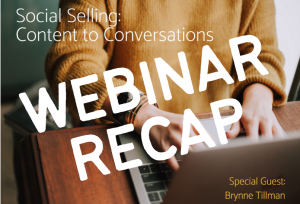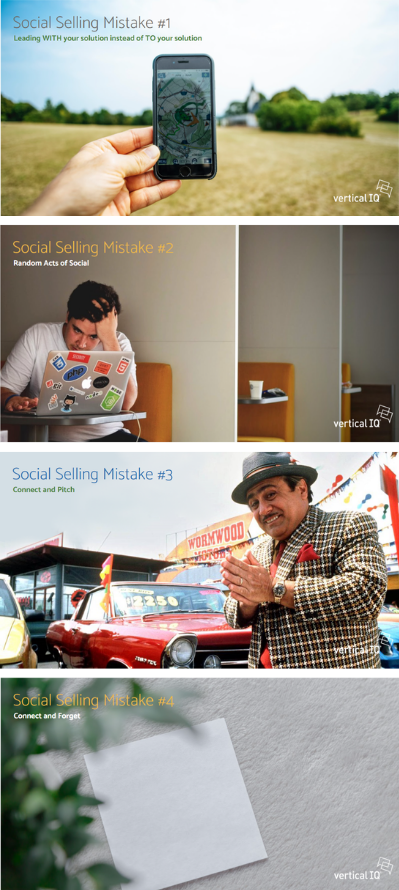 When people hear the word “marketing,” they often think of print or TV advertisements that encourage you to buy one product over another. Those ads infiltrating our subconscious are indeed one aspect of marketing, but there is waaaay more to it than just that, especially since the advent of the internet and social media. That’s why I was especially excited to lead a conversation recently with social selling guru Brynne Tillman.
When people hear the word “marketing,” they often think of print or TV advertisements that encourage you to buy one product over another. Those ads infiltrating our subconscious are indeed one aspect of marketing, but there is waaaay more to it than just that, especially since the advent of the internet and social media. That’s why I was especially excited to lead a conversation recently with social selling guru Brynne Tillman.
Brynne, a former banker and current sales trainer with St. Meyer & Hubbard and CEO at Social Sales Link, has literally written the book on how to use social media as a tool for your sales and marketing efforts. The strategy of “social selling,” Brynne explains, is all about building relationships, providing real value, and being a resource.
She drives home this key point: “It’s not about what the client is worth to you, it’s about what you are worth to the client. … How can I be a resource? How can I bring value? How can I show up in a way that is meaningful?” When we do this enough with the right people, the sales will come when the time is right.
Conversations must be earned
What does it take to get a conversation with all of those would-be clients on social platforms? A warm introduction or engaging with their content isn’t enough. You have to earn a conversation.
Brynne explains why it’s important to master the Ask-Offer Ratio in order to earn that conversation. If you pitch your product too soon in your online interactions, it’s likely that the prospect will feel like it is a bait and switch, and you are going to scare them away.
Instead, you must first share something of value with them — a news article relevant to their industry, for example. You want to be compelling — offering them value in the form of education or insight — in order to get them to “react” in the form of a “like,” a comment, a connection, or even a request for a conversation.
The right Ask-Offer Ratio means that whatever you are sharing should provide them with a resource that is more valuable to the prospect than the amount of time they must invest in reading it.
“Slow down the outreach to speed up the outcome,” as Brynne says.
Your profile matters
Brynne shares some best practices for improving your social media profile (specifically on LinkedIn) and converting it from a resume> to a resource.
In order to attract the right prospects, your profile and content must resonate, spur curiosity, and educate, getting the viewer to think differently about their current banking relationship. Then, use an effective call to action on your profile to get them to take that next step to begin the prospect to client conversion process.
Social selling mistakes
Brynne notes a few things to avoid when it comes to social selling.
 Leading WITH your solution instead of TO your solution
Leading WITH your solution instead of TO your solution
This comes across as a pitch, and prospects will glaze over. Instead, talk about things that matter to the prospect. Get them “leaning in” because you’re sharing things they care about and want to consume. It’s not about developing leads; it’s about developing relationships.
- Random Acts of Social
Logging in occasionally to “like” something or share a post isn’t an effective social selling strategy. You need a consistent, regimented process with defined steps and templates in order to be effective.
- Connect and Pitch
The top social selling mistake people make is leading with their sales pitch — it’s off-putting to nearly everyone. Again, you must earn the right to a conversation by providing value that’s not about you, but rather that’s about what matters to the prospect.
- Connect and Forget
It’s an innocent mistake that many people make: ignoring the people who are already in our network. Think about your current clients, past clients, prospects, partners, vendors, and community leaders. Ask yourself: Who have I been ignoring?
Connecting with insightful content
Brynne recommends exporting your social media connections, as well as using the search/sort functions within LinkedIn, to initiate conversations based on sharing industry-focused, valuable content (a relevant news article, for example). This enables you to essentially create a “template” to share that piece of content with multiple people in that industry with only minor tweaks to personalize it.
When you share that article, be sure to include your thoughts and insights on why you thought the article was of value to the recipient. This shows that you took the time to consume the content as well. And don’t forget to invite them to respond as a way to initiate a back and forth. This can be a high-impact means of outreach.
You can take your discussion to the next level by next sharing content about your prospect’s customer, i.e., the industries that your prospect sells to. This creates a truly customized experience for that prospect — one that adds value and resonates.
Industry content for the win
A big aspect of successful social selling is giving the prospect a compelling reason to switch to your company. This is where adding value, becoming that trusted advisor by sharing industry-specific insight, like the shareable Industry Intelligenceyou’ll find on Vertical IQ, can be crucial.
Brynne explains: Adding value by sharing industry content “proves that they matter to you, that their industry matters to you, that their client’s industry matters to you, because that is how you are going to connect to them differently than any other banker.” In short, sales pros need their social selling outreach mindset to shift from price/rate-focused to value-focused.
Earning the right
As we learned from Brynne, when you bring value to those you want to start a conversation with, you can earn the right to take a few minutes to share with them what you do. If you think we’ve earned the right to tell you more about Vertical IQ, then please consider signing up to get a brief demo: https://verticaliq.com/demo/.